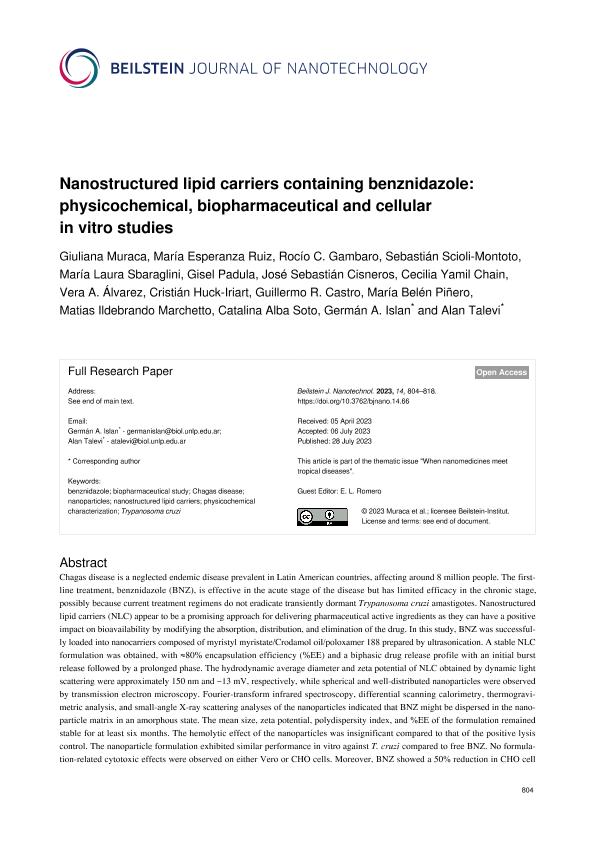Artículo
Nanostructured lipid carriers containing benznidazole: physicochemical, biopharmaceutical and cellular in vitro studies
Muraca, Giuliana Sabrina ; Ruiz, María Esperanza
; Ruiz, María Esperanza ; Gambaro, Rocío Celeste; Scioli Montoto, Sebastián
; Gambaro, Rocío Celeste; Scioli Montoto, Sebastián ; Sbaraglini, Maria Laura
; Sbaraglini, Maria Laura ; Padula, Gisel
; Padula, Gisel ; Cisneros, José Sebastián
; Cisneros, José Sebastián ; Chain, Cecilia Yamil
; Chain, Cecilia Yamil ; Alvarez, Vera Alejandra
; Alvarez, Vera Alejandra ; Huck Iriart, Cristián
; Huck Iriart, Cristián ; Castro, Guillermo Raul
; Castro, Guillermo Raul ; Piñero, María Belén; Marchetto, Matias Ildebrando; Alba Soto, Catalina Dirney
; Piñero, María Belén; Marchetto, Matias Ildebrando; Alba Soto, Catalina Dirney ; Islan, German Abel
; Islan, German Abel ; Talevi, Alan
; Talevi, Alan
 ; Ruiz, María Esperanza
; Ruiz, María Esperanza ; Gambaro, Rocío Celeste; Scioli Montoto, Sebastián
; Gambaro, Rocío Celeste; Scioli Montoto, Sebastián ; Sbaraglini, Maria Laura
; Sbaraglini, Maria Laura ; Padula, Gisel
; Padula, Gisel ; Cisneros, José Sebastián
; Cisneros, José Sebastián ; Chain, Cecilia Yamil
; Chain, Cecilia Yamil ; Alvarez, Vera Alejandra
; Alvarez, Vera Alejandra ; Huck Iriart, Cristián
; Huck Iriart, Cristián ; Castro, Guillermo Raul
; Castro, Guillermo Raul ; Piñero, María Belén; Marchetto, Matias Ildebrando; Alba Soto, Catalina Dirney
; Piñero, María Belén; Marchetto, Matias Ildebrando; Alba Soto, Catalina Dirney ; Islan, German Abel
; Islan, German Abel ; Talevi, Alan
; Talevi, Alan
Fecha de publicación:
07/2023
Editorial:
Beilstein-Institut Zur Forderung der Chemischen Wissenschaften
Revista:
Beilstein Journal of Nanotechnology
e-ISSN:
2190-4286
Idioma:
Inglés
Tipo de recurso:
Artículo publicado
Clasificación temática:
Resumen
Chagas disease is a neglected endemic disease prevalent in Latin American countries, affecting around 8 million people. The firstline treatment, benznidazole (BNZ), is effective in the acute stage of the disease but has limited efficacy in the chronic stage, possibly because current treatment regimens do not eradicate transiently dormant Trypanosoma cruzi amastigotes. Nanostructured lipid carriers (NLC) appear to be a promising approach for delivering pharmaceutical active ingredients as they can have a positive impact on bioavailability by modifying the absorption, distribution, and elimination of the drug. In this study, BNZ was successfully loaded into nanocarriers composed of myristyl myristate/Crodamol oil/poloxamer 188 prepared by ultrasonication. A stable NLC formulation was obtained, with ≈80% encapsulation efficiency (%EE) and a biphasic drug release profile with an initial burst release followed by a prolonged phase. The hydrodynamic average diameter and zeta potential of NLC obtained by dynamic light scattering were approximately 150 nm and −13 mV, respectively, while spherical and well-distributed nanoparticles were observed by transmission electron microscopy. Fourier-transform infrared spectroscopy, differential scanning calorimetry, thermogravimetric analysis, and small-angle X-ray scattering analyses of the nanoparticles indicated that BNZ might be dispersed in the nanoparticle matrix in an amorphous state. The mean size, zeta potential, polydispersity index, and %EE of the formulation remained stable for at least six months. The hemolytic effect of the nanoparticles was insignificant compared to that of the positive lysis control. The nanoparticle formulation exhibited similar performance in vitro against T. cruzi compared to free BNZ. No formulation-related cytotoxic effects were observed on either Vero or CHO cells. Moreover, BNZ showed a 50% reduction in CHO cell viability at 125 μg/mL, whereas NLC-BNZ and non-loaded NLC did not exert a significant effect on cell viability at the same concentration. These results show potential for the development of new nanomedicines against T. cruzi.
Archivos asociados
Licencia
Identificadores
Colecciones
Articulos(CCT - LA PLATA)
Articulos de CTRO.CIENTIFICO TECNOL.CONICET - LA PLATA
Articulos de CTRO.CIENTIFICO TECNOL.CONICET - LA PLATA
Articulos(IGEVET)
Articulos de INST.DE GENETICA VET ING FERNANDO NOEL DULOUT
Articulos de INST.DE GENETICA VET ING FERNANDO NOEL DULOUT
Articulos(INIFTA)
Articulos de INST.DE INV.FISICOQUIMICAS TEORICAS Y APLIC.
Articulos de INST.DE INV.FISICOQUIMICAS TEORICAS Y APLIC.
Citación
Muraca, Giuliana Sabrina; Ruiz, María Esperanza; Gambaro, Rocío Celeste; Scioli Montoto, Sebastián; Sbaraglini, Maria Laura; et al.; Nanostructured lipid carriers containing benznidazole: physicochemical, biopharmaceutical and cellular in vitro studies; Beilstein-Institut Zur Forderung der Chemischen Wissenschaften; Beilstein Journal of Nanotechnology; 14; 7-2023; 804-818
Compartir
Altmétricas



